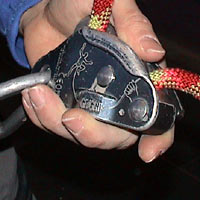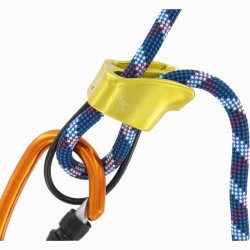Petzl Gri Gri

If
you have ever climbed in an indoor gym, you have most likely seen or
used a Gri Gri. Indoor gyms usually opt to use Gri Gris because they are more dummy-proof than the ATC. They come with easy-to understand
instruction on how to load the rope etched onto the device itself (see
photo), and are assisted braking devices. But don't be fooled into thinking it is entirely safe! Many climbers dislike the GriGri precisely because it can lull a belayer into a false sense of security. In 2010, a climber leaned back at the top of a climb when his belayer was not providing a brake. The climber fell 30 feet before the GriGri arrested his fall. The climber broke his ankle and needed to be air rescued! (Source: AAC Accidents in North American Mountaineering 2010)
Indoor gyms also don't care about weight since there is no strenuous approach hike, so the fact that the Gri Gri weighs twice as much as the ATC does not really matter to them. It is easy to pay out rope and take in slack as the climber ascends on top rope. Although the Gri Gri is brake assisted, you should still always keep your brake hand on the slack side of the rope and positioned near your hip.
To load the Gri Gri, you open the device by pivoting one face. The device opens as if you are spreading your card hand for a game of poker. Once open, you thread the rope through the device so that the slack side of the rope enters on the right and the climber side of the rope exits on the left. Again, there are visual instructions on how to do this etched onto the device, so it is easy to understand. Even though it is easy to do, it is very important to do it right! If you load it improperly, the device will not provide a brake on the rope, and the Gri Gri will be rendered useless! It's simple, so don't skrew it up.
ALWAYS ALWAYS ALWAYS consult the instructions provided by the manufacturer! Do not use this site as your only form of instruction! Don't be an idiot!
Watch this video (from Petzl) to see the Gri Gri in action. Be sure to watch all the way until the end, where they demonstrate a common technique used with the Gri Gri that is wrong and dangerous.
Indoor gyms also don't care about weight since there is no strenuous approach hike, so the fact that the Gri Gri weighs twice as much as the ATC does not really matter to them. It is easy to pay out rope and take in slack as the climber ascends on top rope. Although the Gri Gri is brake assisted, you should still always keep your brake hand on the slack side of the rope and positioned near your hip.
To load the Gri Gri, you open the device by pivoting one face. The device opens as if you are spreading your card hand for a game of poker. Once open, you thread the rope through the device so that the slack side of the rope enters on the right and the climber side of the rope exits on the left. Again, there are visual instructions on how to do this etched onto the device, so it is easy to understand. Even though it is easy to do, it is very important to do it right! If you load it improperly, the device will not provide a brake on the rope, and the Gri Gri will be rendered useless! It's simple, so don't skrew it up.
ALWAYS ALWAYS ALWAYS consult the instructions provided by the manufacturer! Do not use this site as your only form of instruction! Don't be an idiot!
Watch this video (from Petzl) to see the Gri Gri in action. Be sure to watch all the way until the end, where they demonstrate a common technique used with the Gri Gri that is wrong and dangerous.

